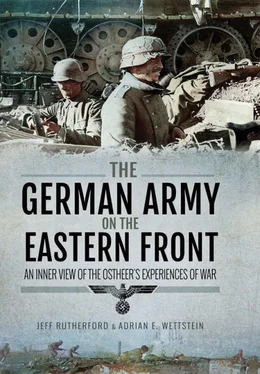
First published in Great Britain in 2018 by
Pen & Sword Military
an imprint of
Pen & Sword Books Ltd
47 Church Street
Barnsley
South Yorkshire
S70 2AS
Copyright (c) Jeff Rutherford and Adrian E. Wettstein 2018
ISBN 978-1-47386-174-9
eISBN 978-1-47386-176-3
Mobi ISBN 978-1-47386-175-6
The right of Jeff Rutherford and Adrian E. Wettstein to be identified as Authors of this Work has been asserted by them in accordance with the Copyright, Designs and Patents Act 1988.
A CIP catalogue record for this book is available from the British Library
All rights reserved. No part of this book may be reproduced or transmitted in any form or by any means, electronic or mechanical including photocopying, recording or by any information storage and retrieval system, without permission from the Publisher in writing.
Pen & Sword Books Ltd incorporates the imprints of Pen & Sword Archaeology, Atlas, Aviation, Battleground, Discovery, Family History, History, Maritime, Military, Naval, Politics, Railways, Select, Social History, Transport, True Crime, and Claymore Press, Frontline Books, Leo Cooper, Praetorian Press, Remember When, Seaforth Publishing and Wharncliffe.
For a complete list of Pen & Sword titles please contact
PEN & SWORD BOOKS LIMITED
47 Church Street, Barnsley, South Yorkshire, S70 2AS, England
E-mail: enquiries@pen-and-sword.co.uk
Website: www.pen-and-sword.co.uk
Stephen Fritz, Ostkrieg: Hitler’s War of Extermination in the East , p. 470.
Ibid., p. 471.
Elements of Army Group North that retreated into East Prussia and Latvia following the Red Army’s offensive that liberated Leningrad were eventually pushed into what became known as the Courland Pocket, where some 500,000 men – though only half could be counted as true front line troops – held out until the end of the war in May 1945; see Karl-Heinz Frieser, ‘Die Rückzugskämpfe der Heeresgruppe Nord bis Kurland,’ in Karl-Heinz Frieser et. al, Die Ostfront 1943/44: Der Krieg im Osten und an den Nebenfronten , volume 8, Das Deutsche Reich und der Zweite Weltkrieg , pp. 623-678.
The best examination of the decisive panzer thrust – that of Army Group Centre’s Panzer Groups 2 and 3 – during Operation Barbarossa is David Stahel’s Operation Barbarossa and Germany’s Defeat in the East .
A balanced analysis of these issues is found in Gerhard P. Groß, Mythos und Wirklichkeit: Geschichte des operative Denkens im deutschen Heer von Moltke d.Ä. bis Heusinger , pp. 225-232.
See Ernst Klink, The Conduct of Operations,’ in Germany and the Second World War , vol. 4, The Attack on the Soviet Union , pp. 525-569, Ben Shepherd, Hitler’s Soldiers: The German Army in the Third Reich , pp. 134-141.
Panzergruppe 3/Ia, Gefechtsbericht vom 22. – 29.6.41, 29.6.41, Bundesarchiv-Militärarchiv, hereafter (BA-MA) RH 21-3/46. The authors graciously thank Dr. David Stahel for providing a copy of this document.
Oberkommando des Heeres or Army High Command.
See the chart ‘Casualties for all Divisions per Month,’ in Christian Hartmann, Wehrmacht im Ostkrieg: Front und militärisches Hinterland 1941/42 , pp. 212. For more on how German divisions experienced the opening days of the campaign, see Jeff Rutherford, Combat and Genocide on the Eastern Front: The German Infantry’s War, 1941-1944 , pp. 84-5.
Fritz, Ostkrieg , p. 88.
8. Panzer Division/Ia, KTB, 6.7.41, National Archives and Record Administration hereafter (NARA) T-315, Roll 483; KTB, 19.10.41, 31.10.41, NARA T-315, Roll 484.
For more on this issue as it relates to logistics, see chapter 4.
XXXXVII. Panzer Korps/Ia, Kriegstagebuch Nr.2., 19.7.41, BA-MA RH 24-47/2. The authors graciously thank Dr. David Stahel for providing a copy of this document.
7. Infanterie-Division/Ia, Kommandeur-Besprechung, 15.8.41, NARA T-315, Roll 374.
The commander was stating that a linear defence necessarily concentrated the men at the front, leaving very few in reserve. Without a reserve that could eliminate any enemy penetration of the defensive front, any breakthrough threatened the position as a whole.
David Stahel, Kiev, 1941: Hitler’s Battle for Supremacy in the East , p. 302.
[7. Infanterie-Division/Ia], Betr.: Kurzbericht über die Kämpfe im Jelnja-Abschnitt, 29.9.1941, NARA T-315, Roll 397.
The document referred to the ongoing encirclement battle centered on Kiev.
David Stahel, The Battle for Moscow, 1941.
14. Panzer Division/Ia, KTB, 21.11.41; 29.11.41, NARA T-315, Roll 656.
Panzer-Regiment 10/Kommandeur, An 8. Panzer-Division/Ia, 14.12.1941, NARA T-315, Roll.
Fritz, Ostkrieg , p. 205.
VII. Armeekorps/Ia., Betrifft: Lage und Kampfführung im Osten, 3.1.42 NARA T-316, Roll 376.
VII. Armeekorps/Ia, Korpsbefehl für die Kampfführung in der Winterstellung, 3.1.42, NARA T-315, Roll 376.
7. Infanterie-Division/Ia, KTB, 4.1.42, NARA T-315, Roll 372.
126. Infanterie-Division/Ia, KTB, 22.1.42, BA-MA RH 26-126/34.
The most authoritative examination of the Stalingrad campaign from the German perspective remains Bernd Wegner, ‘The War against the Soviet Union, 1942-1943,’ in Horst Boog, et. al, Germany and the Second World War , volume VI, The Global War , pp. 843-1172.
XXXXVIII. Panzer Korps/Ia, KTB, 6.9.42, NARA T-314, Roll 1153.
On 5 December 1757, Frederick the Great’s small, yet more mobile and better-drilled army maneuvered around the flank of the much larger Austrian force near the town of Leuthen and decisively smashed the Hapsburg forces. The battle passed into Prussian and later German lore as the triumph of skill, determination, and will in the face of superior forces.
71. Infanterie-Division/Ia, Kampfstärken der 71. Div. am 19.9.1942 (Anlage), o.D., BA-MA RH 20-6/212.
For a detailed calculation, see Adrian Wettstein, Die Wehrmacht im Stadtkampf 1939-1942 , pp. 306-315.
XI. Armeekorps/Kommandierender Generanl, Dem Oberbefehlshaber der 6. Armee, 27.9.1942, BA-MA RH 20-6/213.
Führererlass (literally: leaders decree) is an order given directly by Adolf Hitler.
Pionier-Bataillon 179, Angriff auf den Nordwestteil der Martinofenhallen des Roten Oktober (Halle 4) am 11. November 1942. Gefechtsbericht, 12.11.42, BA-MA RH 26-79/61.
Читать дальше







![John Stieber - Against the Odds - Survival on the Russian Front 1944-1945 [2nd Edition]](/books/405234/john-stieber-against-the-odds-survival-on-the-russian-front-1944-1945-2nd-edition-thumb.webp)





